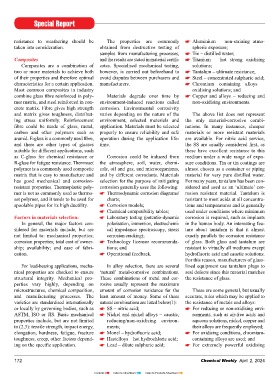Page 172 - CW E-Magazine (2-4-2024)
P. 172
Special Report
resistance to weathering should be The properties are commonly Aluminium – non-staining atmo-
taken into consideration. obtained from destructive testing of spheric exposure;
samples from manufacturing processes, Tin – distilled water;
Composites and the results are stated in material certifi- Titanium – hot strong oxidising
Composites are a combination of cates. Specialised mechanical testing, solutions;
two or more materials to achieve both however, is carried out beforehand to Tantalum – ultimate resistance;
of their properties and therefore optimal avoid disputes between purchasers and Steel – concentrated sulphuric acid;
characteristics for a certain application. manufacturers. Chromium containing alloys –
Most common composites in industry oxidising solutions; and
combine glass fibre reinforced in poly- Materials degrade over time by Copper and alloys – reducing and
mer matrix, and steel reinforced in con- environment-induced reactions called non-oxidising environments.
crete matrix. Fibre gives high strength corrosion. Environmental corrosivity
and matrix gives toughness, distribut- varies depending on the nature of the The above list does not represent
ing stress uniformly. Reinforcement environment, selected materials and the only material-corrosive combi-
fibre could be made of glass, metal, application. Materials must be selected nations. In many instances, cheaper
carbon and other polymers such as properly to ensure reliability and safe materials or more resistant materials
aramid. E-glass is a commonly used fibre, operation during the application life- are available. For nitric acid service,
and there are other types of glasses time. the SS are usually considered first, as
suitable for different applications, such these have excellent resistance to this
as C-glass for chemical resistance or Corrosion could be induced from medium under a wide range of expo-
R-glass for fatigue resistance. Thermoset the atmosphere, soil, water, chemi- sure conditions. Tin or tin coatings are
polymer is a commonly used composite cals, oil and gas, and microorganisms, almost chosen as a container or piping
matrix that is easy to manufacture and and by different corrodants. Materials material for very pure distilled water.
has good mechanical and corrosion- selection for the purpose of mitigating For many years, tantalum has been con-
resistant properties. Thermoplastic poly- corrosion generally uses the following: sidered and used as an ‘ultimate’ cor-
mer is not as commonly used as thermo- Thermodynamic corrosion diagrams/ rosion resistant material. Tantalum is
set polymer, and it tends to be used for charts; resistant to most acids at all concentra-
spoolable pipes for its high ductility. Corrosion models; tions and temperatures and is generally
Chemical compatibility tables; used under conditions where minimum
Factors in materials selection: Laboratory testing (potentio-dynamic corrosion is required, such as implants
In general, the major factors con- polarisation, immersion, electrochemi- in the human body. An interesting fea-
sidered for materials include, but are cal impedance spectroscopy, stress ture about tantalum is that it almost
not limited to: mechanical properties; corrosion cracking); exactly parallels the corrosion resistance
corrosion properties; total cost of owner- Technology licensor recommenda- of glass. Both glass and tantalum are
ship; availability; and ease of fabri- tions; and resistant to virtually all mediums except
cation. Operational feedback. hydrofluoric acid and caustic solutions.
For this reason, manufacturers of glass-
For load-bearing applications, mecha- In alloy selection, there are several lined equipment use tantalum plugs to
nical properties are checked to ensure ‘natural’ metal-corrosive combinations. seal defects since this material matches
structural integrity. Mechanical pro- These combinations of metal and cor- the resistance of glass.
perties vary highly, depending on rosive usually represent the maximum
microstructures, chemical composition, amount of corrosion resistance for the These are some general, but usually
and manufacturing processes. The least amount of money. Some of these accurate, rules which may be applied to
varieties are standardised internationally natural combinations are listed below(1): the resistance of metals and alloys:
or locally by governing bodies, such as SS – nitric acid; For reducing or non-oxidising envi-
ASTM, ISO or JIS. Basic mechanical Nickel and nickel alloys – caustic, ronments, such as air-free acids and
properties include, but are not limited reducing/non-oxidising environ- aqueous solutions, nickel, copper and
to (2,3): tensile strength, impact energy, ments; their alloys are frequently employed;
elongation, hardness, fatigue, fracture Monel – hydrofluoric acid; For oxidising conditions, chromium-
toughness, creep, other factors depend- Hastelloys – hot hydrochloric acid; containing alloys are used; and
ing on the specific application. Lead – dilute sulphuric acid; For extremely powerful oxidising
172 Chemical Weekly April 2, 2024
Contents Index to Advertisers Index to Products Advertised

